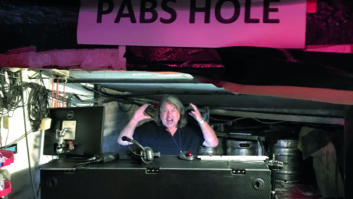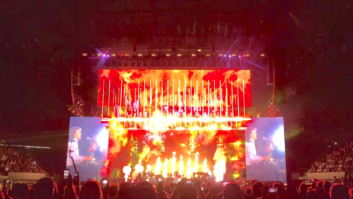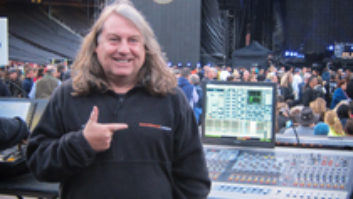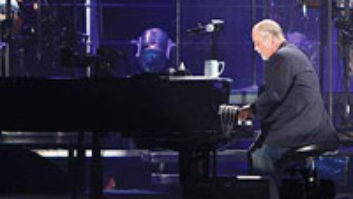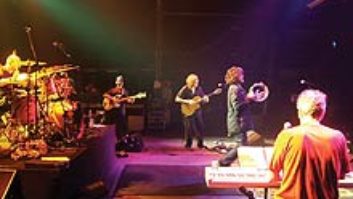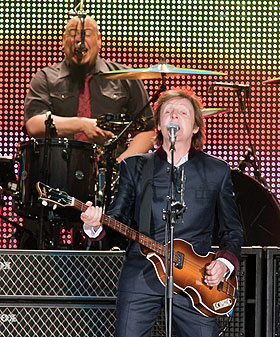
Photos: Dave Vann
For the past 22 years, front-of-house engineer Paul “Pab” Boothroyd has had the best seat in the house for Sir Paul McCartney’s world tours. Granted, he has to work while the rest of the world gets to sit back or bop along, but he wouldn’t change chairs with anyone. It’s too good a show to miss. Mix caught up with the tour in mid-July at Yankee Stadium—McCartney’s return to New York City—to kick off his new On the Run tour, which spotlights hits from his near-50-year career.
CHANGES IN THE RIG
During his tenure with McCartney, Boothroyd has seen numerous changes in technology—some he’s brought into his rig, others he’s dismissed. “You adapt to new technology that comes out,” Boothroyd says. “You take it onboard and see whether it will do anything differently and better. New microphones, recording techniques and mixing platforms. There’s so much out there now, it’s a vast choice from when I first started working with him. I think I started out with a Midas XL3 and then to an XL4—a great analog console—and racks and racks of toys, and now I’m on an [Avid] Profile, which is a very powerful but small console. It’s a good thing because Paul tends to play a lot of different-sized venues—from clubs to really anywhere; I think I mixed inside a cupboard when we were at The Cavern [Liverpool]. It was the only place we could go because the room was so full that we took the doors off of a broom cupboard and I set up in there. [Laughs] You think about all this kind of stuff and you apply what’s around to the job, and if it’s the right thing for the right job, then you use it.
“When new things come out, it’s all exciting and everyone wants to have the latest toy,” he continues. “Just like the latest versions of software. It’s always good to let something sneak on by for a month or two and wait for the bugs to be out. I see what the gossip is—if people are enjoying it and finding good things about it—then I put my own hands on it and see what I think. And if I think it’ll do the job better, than I would slowly move around to it. With Paul, there’s a lot at stake when you’re doing big shows all the time—40,000 to 50,000-plus people—you don’t want to just use something for the sake of using it and then it lets you down.”
With the Profile, Boothroyd is making extensive use of the onboard snapshots, especially with the 50-plus songs McCartney plays each day. “I have many songs on snapshots, which puts everything in order very quickly,” he says. “Our show is about three hours long, and Paul will soundcheck every day and he’ll play for about an hour and do different songs for a V.I.P. audience during soundcheck. Four hours of music just in a day and covering different songs; it’s good to recall from a list and go straight into it a bit more accurately than just doing it manually. With the different sounds and eras of his music, I’ve built in different tweaks that put the song immediately into the character of when it was recorded. So snapshots are really useful for those different EQs on vocals, reverbs, et cetera.”
As for effects, Boothroyd employs a general vocal reverb that he’ll tweak per song—a bit longer or a little more pre-delay. “Paul has basic effects; he likes his ADT delays, a little bit of Harmonizing on BVs, an Eventide HP5000 pitch-shift/delay just to give a bit of shimmer and some mono delay on some songs. Toms reverb, snare reverb and that’s about it. Everything’s onboard; it’s what the desk can offer. Thinking about, ‘Maybe I’ll be in a cupboard’ theory, it’s great. Also traveling a lot with him, all I really need is the console. I just keep it all onboard now and I don’t think anything suffers for it.”

Front-of-house engineer Paul “Pab” Boothroyd at the Avid Profile
STADIUM-SPECIFIC P.A.
The slimmed-down FOH gear is provided by Clair Global, a sound company McCartney has worked with since its ShowCo days. Boothroyd works extensively with the company’s M.L. Procise, whom he calls his “partner in crime.” In addition to the gear, Clair Global also has an audio crew in force—FOH and monitor techs, as well as system tech Chris Nichols, with whom Boothroyd had worked on previous AC/DC and Paul Simon tours. “We’re in a stadium mode, so with delays and delay towers, there’s a lot going on, and we have to get in, get it up fast and make it work. Great crew,” enthuses Boothroyd.

The tour is using the latest version of the Clair line array, the i5. Boothroyd has used this type of rig on McCartney since the introduction of the i4 and has grown with it. “The i5 is a good, tough P.A. for doing a lot of outdoor shows, which is what we do. It’s fine in arenas, also,” says Boothroyd. “We use the new iDL cabinets on the delay towers, which are great. We’ve been getting really good results—the promoters and Barry Marshall, our tour director, and our production manager Mark Springs constantly walk the buildings and check that everything’s going okay, and they come back with their smiling faces and give us glowing reports of how it’s covering the venues.
“We’re doing ballparks at the moment, which are yet another shape,” he continues. “The mix position is normally on second base. It’s been great, I can’t complain. With the i5, you can change various angles of the boxes and shape of the array. Clair has a shoot program where you take measurements of the building with a laser measure and you put it into a program and it gives you the different angles you need to set the array to. So we shoot each venue as an entity and build the P.A. accordingly. That’s pretty important because you don’t want to be firing at ceilings or glass walls if you can help it. “
Being in ballparks, do Boothroyd and system tech Nichols have any problem containing the low end? “With Paul’s show, a lot of his music isn’t really about masses of sub-bass,” Boothroyd replies, “and you think about The Beatles’ music and it’s not really a massive kick drum sound. [We have] a full-range P.A. with a lot of bass coming from the flown arrays, and then I bring in the subs just to anchor that sound, just to give it a bit of feel. That way, I don’t want to be battering people sitting in those first rows in front of the sub blocks. I leave the subs off and get the sound going in the flown part of the rig and then just bring in the subs to add a bit of weight. Working like that, you can get the bass a bit more even around the building. I have a method of tuning with my system engineer and we also use some of the other special bass frequency–controlling programs that Clair has developed, which adds to any evenness, as well.”
MICS AROUND THE STAGE
While Boothroyd has changed up his fair share of consoles during the years, there are some things with a McCartney tour that just don’t get messed with—namely, his vocal mic: a Shure 58A. “Paul’s very old school and he doesn’t need to get too crazy with stuff; if it sounds fine, he’s happy with it. And he’ familiar with a 58 and how he sings with it.” All background vocals (Paul “Wix” Wickens, keyboards; Rusty Anderson, guitar; Brian Ray, guitar/bass) except Abe Laboriel Jr. (drums) are 58As; for Laboriel Jr., Boothroyd employs a 57A due to proximity.
“Drum mics I might experiment with and have done,” Boothroyd says. “I like the Audix range—D6 in the kick, D4 on toms, i5 on snare. I’ve had great success with them. For cymbals, I’ve got DPAs. We have massive video screens behind our sets so I didn’t want lots of overhead mics and stands cluttering Abe’s world; I wanted to keep it minimalistic and let him stand out. He’s a character and a big part of the show. He’s very visual in the way he plays so I don’t leave a lot of hardware around him. I do undermiking on the cymbals and the ride with the DPAs.”
Guitars see a mixture of Shure and RODE, while DIs are “everything from Avalons to the Radials,” Boothroyd says. “Basically, I try stuff with an individual instrument, and if it seems to make it sound more correct or better, then I pick out one. A multitude of sound around the stage.”
CONSTANT RECORDING
Boothroyd is also multitrack recording (Pro Tools|HD rig connected directly to the Profile, tracking about 70 inputs) every show, including soundcheck. And the reason for pressing Record during soundcheck, Boothroyd says, is because “sometimes he’ll just jam on a song and he likes to get that down on tape, so to speak, and then it’s up to me to make sure it’s properly captured. We basically record everything he does. As soon as he steps on the stage, I hit Record and it doesn’t stop until he leaves.”
In addition to the inputs coming off the stage, Boothroyd includes four shotgun audience mics (placed at the downstage edge of the stage) and a couple of X/Y mics into the mix. There are about eight channels of ambience to capture audience sounds. “We’ve used recordings for live releases, but I think it’s mainly for the archiving side,” Boothroyd says. “If it’s a special show and we know it’s going to be a film shoot and we’ll be multitracking, then we probably will get a redundant Pro Tools rig—or I become the redundant rig! [Laughs]—as a safety and we’ll add more audience mics, et cetera.”
After so many years working with McCartney, Boothroyd has the artist’s sound dialed in—with or without technology updates. The two have formed a wonderful professional bond that goes beyond the mixing board. “It’s a privilege because he’s such a nice guy anyway,” Boothroyd says. “He’s just a very professional, talented person. He’s conscientious about his performance yet never forgets music should be about fun, and when he’s up on that stage, he’s enjoying himself. We have our little banter during soundcheck with talkback mics: Being a fellow Liverpudlian, we go off into our little accents and jokes. It’s great and a privilege.”
Sarah Benzuly is
Mix
’s managing editor.
Sir Paul McCartney Tour Gallery
